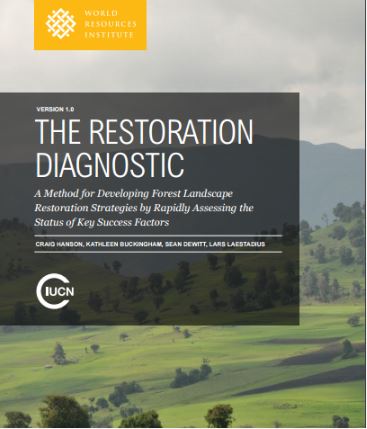In December of 2015, the World Resources Institute, working with IUCN, published “The Restoration Diagnostic: A Method for Developing Forest Landscape Restoration Strategies by Rapidly Assessing the status of Key Success Factors” by Craig Hanson, Kathleen Buckingham, Sean DeWitt, and Lars Laestadius. It combines analyses, practice recommendations, and case studies from around the world.
From the Executive Overview: Most countries around the world have an untapped resource opportunity lying within their borders: the restoration of forest landscapes.
Forest landscape restoration is the process of regaining ecological functionality and enhancing human well-being across cleared or degraded forest landscapes. It can result in a variety of land uses, ranging from vast tracts of dense natural forests, to high-yield agroforestry systems, to a mosaic of wooded areas amid productive agricultural fields. Forest landscape restoration does not call for increasing tree cover beyond what would be ecologically appropriate for a particular location.
Forest landscape restoration can yield a number of economic, social, and environmental benefits. Economically, it can diversify economies, reduce damages from natural hazards, generate marketable forest and agricultural products, and support recreation and tourism. Socially, it can create jobs, help alleviate local poverty, increase food security, support cultural heritage, and strengthen national pride. Environmentally, it can improve and sustain soil and water quality, conserve biodiversity, and help people mitigate and adapt to climate change.
Furthermore, forest landscape restoration can help governments meet several national and international agreements and commitments including those regarding reduced emissions from deforestation and forest degradation in developing countries (REDD+), the Convention to Combat Desertification, the Convention on Biological Diversity, the Sustainable Development Goals, the New York Declaration on Forests, and the Bonn Challenge.
History indicates that forest landscape restoration is possible. Many countries—including Costa Rica, Niger, South Korea, Sweden, and the United States—have recovered forest landscapes during the past century in a manner that could be considered “successful” in terms of being at a significant scale and generating stakeholder benefits. Our analysis of these and other historical case studies—16 in all—complemented by peer-reviewed literature suggests that a successful restoration process exhibits three common themes:
- A clear motivation. Decision makers, landowners, and/or citizens were inspired or motivated to catalyze processes that led to forest landscape restoration.
- Enabling conditions in place. A number of ecological, market, policy, social, and institutional conditions were in place that created a favorable context for forest landscape restoration.
- Capacity and resources for sustained implementation. Capacity and resources were mobilized to implement forest landscape restoration on a sustained basis on the ground.
Within each theme, our research points to a number of factors that were present―either naturally or through human action―in cases where forest landscape restoration processes occurred. We call these “key success factors” for forest landscape restoration (Table ES-1). We do not use this term to necessarily imply causation; establishing causal links requires additional research. Rather, our assessment indicates that a large number of these factors were in place where restoration has occurred in the past.

